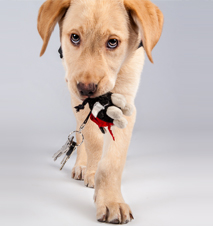Assistance dogs are specially trained dogs who learn tasks so they can help their owners with serious disabilities in their day-to-day lives.
Unfortunately, therapy dogs are still often equated, or confused with, assistance dogs. Therapy dogs have nothing to do with assistance dogs and - in contrast to assistance dogs - have no rights in public spaces.
Assistance dogs are always just trained for one person, and they learn at least three tasks which can directly reduce the disability of their partner. That's not all they do however. They have to keep to high standards in public - for example, they are not allowed to sniff things and have to ignore other people and dogs. Assistance dogs are trained for about two years in order to meet these requirements. They accompany their disabled partners 24 hours a day. The partner is reliant upon the assistance of their assistance dog when they go shopping or visit the doctor.
Therapy dogs are mostly employed by medical staff in their work - for example in an occupational therapy practice. They help several different people, not just the one partner. Dogs who visit old people's homes or kindergartens help lots of different people. Dogs who live with a disabled person and support them emotionally by their presence are also called therapy dogs. These dogs - in contrast to assistance dogs - have not completed any two-year-long special training, do not adhere to any standards and do not fulfill at least three direct tasks for "their" disabled people. In the USA these dogs are called "emotional support dogs". Therapy dogs are not assistance dogs.
While assistance dogs were in German speaking countries previously also called disability companion dogs or helping hounds, this expression is hardly used today as no person like to constantly be referred to as disabled. At the end of the day they are completely normal people! The expression "Servicehund" ("service dog") is occasionally also used. In the USA "service dog" generally refers to all assistance dogs and is a commonly used term, but in the UK assistance dogs can only be referred to as assistance dogs and not as service dogs. In the UK all working dogs, including rescue dogs, therapy and visitor dogs, are regarded as service dogs. In the Benelux countries, the term "help dog" ("helphond") if often used, referring directly to the service the dogs provide.
In the meantime the term "assistance dog" is most often used worldwide. Different assistance dogs have their own names however, according to the work they carry out for their partner:
- Guide dogs Guide dogs lead a visually impaired person with a harness. They inform their person of steps, obstacles, entrances, exits, post boxes and switches and lead them safely though the street traffic.
- Mobility dogs: Mobility dogs help someone who has restricted mobility and is reliant on a wheelchair, crutches or a prosthetic. They help a person in coping with everyday life by picking up objects from the floor, fetching things from shelves and pressing light switches and buttons. They open and close doors, drawers and cupboards, drag wheelchairs and help with getting dressed and undressed.
- Balance dogs: Balance dogs give physical support to someone who has difficulties walking. They wear a mobility harness which the partner can hold onto.
- PTSD assistance dogs: PTSD assistance dogs help someone with a complex post-traumatic stress disorder and/ or a dissociative disorder. They wake their people up when they have nightmares and turn the light on, disrupt flashbacks and dissociative episodes, lead the way to a calm place during panic attacks, create distance, bark on command, search rooms for intruders, make sure that no-one approaches unnoticed from behind when a door is opened, go first into dark rooms and act as a calming presence.
- Diabetes alert dogs: Diabetes alert dogs alert type 1 diabetics of impending hypoglycemia and hyperglycemia. They provide the diabetic with security and save lives daily.
- Assistance dogs for people with psychological and psychiatric illnesses: Assistance dogs for people schizophrenia, eating disorders, severe depression, bipolar disorder and borderline personality disorder learn specific tasks to help their partners in their day-to-day life. Tasks include tactile signals which make the person aware of their behavior or change in them-self, creating distance and leading the way to a calm area or a seat.
- Seizure alert dogs: Epilepsy alert dogs alert a few minutes before a focal seizure so that the epileptic can sit down and avoid falling.
- Seizure response dogs: Epilepsy response dogs primarily help those who suffers from generalized seizures. They fetch help when a seizure occurs, ring a bell or press an emergency button, fetch medicine for the assistance person and remain with the epileptic after the seizure.
- Autism assistance dogs: Autism assistance dogs learn individual tasks to make the life of a child or adult with autism easier. Tasks include calming the person down during melt downs, providing a sense of security in crowds and informing someone when the child runs away.
- Asthma alert dogs: Asthma alert dogs help by alerting the person just before a life-threatening asthma attack, so that the person can take measures to ensure that the attack doesn't become worse.
- Medical alert and response dogs: Medical alert dogs help with various illnesses, such as narcolepsy, Addison's disease and heart disease. They notice threatening situations and fetch help in emergencies.
- Allergen detection dogs: Allergen detection dogs signal the presence of an allergen for those with serious, life-threatening allergies.
- Stroke alert dogs: Stroke alert dogs help patients who have already had a stroke or have a high probability of having a stroke. They alert of an oncoming stroke and fetch help to prevent the situation from becoming worse.
- FAS assistance dogs: FAS assistance dogs help children who are affected by FAS. They calm the child if they get overstimulated, and lead them to exits and secure locations in public places.
- Dementia assistance dogs: Dementia assistance dogs help relatives of dementia sufferers living at home to cope with their day-to-day lives. They provide the dementia sufferer with warmth and closeness and notify the relative when the dementia sufferer leaves the home without warning.










